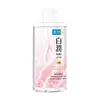What's inside
What's inside
 Key Ingredients
Key Ingredients

 Benefits
Benefits

 Concerns
Concerns

 Ingredients Side-by-side
Ingredients Side-by-side

Water
Skin ConditioningPoloxamer 124
EmulsifyingSodium Ascorbyl Phosphate
AntioxidantNiacinamide
SmoothingVaccinium Macrocarpon Fruit Juice
Skin ConditioningCitrus Limon Juice
Skin ConditioningAscorbic Acid
AntioxidantSodium Hyaluronate
HumectantGlycerin
HumectantDecyl Glucoside
CleansingSodium Cocoamphoacetate
CleansingSodium Chloride
MaskingCitric Acid
BufferingMaltodextrin
Absorbent1,2-Hexanediol
Skin ConditioningTrisodium EDTA
Sodium Benzoate
MaskingPotassium Sorbate
PreservativePhenoxyethanol
PreservativeBHT
AntioxidantWater, Poloxamer 124, Sodium Ascorbyl Phosphate, Niacinamide, Vaccinium Macrocarpon Fruit Juice, Citrus Limon Juice, Ascorbic Acid, Sodium Hyaluronate, Glycerin, Decyl Glucoside, Sodium Cocoamphoacetate, Sodium Chloride, Citric Acid, Maltodextrin, 1,2-Hexanediol, Trisodium EDTA, Sodium Benzoate, Potassium Sorbate, Phenoxyethanol, BHT
Water
Skin ConditioningGlycerin
HumectantPEG-7 Caprylic/Capric Glycerides
EmulsifyingPropanediol
SolventPEG-6 Caprylic/Capric Glycerides
EmulsifyingSodium Cocoamphoacetate
CleansingChlorphenesin
AntimicrobialPEG/PPG/Polybutylene Glycol-8/5/3 Glycerin
HumectantXylitylglucoside
HumectantPolyaminopropyl Biguanide
PreservativeSodium Chloride
MaskingAnhydroxylitol
HumectantDisodium EDTA
Xylitol
HumectantSodium Hyaluronate
HumectantPhytic Acid
3-O-Ethyl Ascorbic Acid
Skin ConditioningSalicylic Acid
MaskingPotassium Azeloyl Diglycinate
Skin ConditioningAmylopectin
Dextrin
AbsorbentXanthan Gum
EmulsifyingButylene Glycol
Humectant1,2-Hexanediol
Skin ConditioningPhenoxyethanol
PreservativePentylene Glycol
Skin ConditioningPolyquaternium-10
Hydrolyzed Sodium Hyaluronate
Skin ConditioningMoringa Oleifera Seed Extract
Skin ConditioningBiosaccharide Gum-4
Skin ConditioningDisodium Phosphate
BufferingPotassium Chloride
Citric Acid
BufferingCaprylyl Glycol
EmollientWater, Glycerin, PEG-7 Caprylic/Capric Glycerides, Propanediol, PEG-6 Caprylic/Capric Glycerides, Sodium Cocoamphoacetate, Chlorphenesin, PEG/PPG/Polybutylene Glycol-8/5/3 Glycerin, Xylitylglucoside, Polyaminopropyl Biguanide, Sodium Chloride, Anhydroxylitol, Disodium EDTA, Xylitol, Sodium Hyaluronate, Phytic Acid, 3-O-Ethyl Ascorbic Acid, Salicylic Acid, Potassium Azeloyl Diglycinate, Amylopectin, Dextrin, Xanthan Gum, Butylene Glycol, 1,2-Hexanediol, Phenoxyethanol, Pentylene Glycol, Polyquaternium-10, Hydrolyzed Sodium Hyaluronate, Moringa Oleifera Seed Extract, Biosaccharide Gum-4, Disodium Phosphate, Potassium Chloride, Citric Acid, Caprylyl Glycol
Ingredients Explained
These ingredients are found in both products.
Ingredients higher up in an ingredient list are typically present in a larger amount.
1,2-Hexanediol is a synthetic liquid and another multi-functional powerhouse.
It is a:
- Humectant, drawing moisture into the skin
- Emollient, helping to soften skin
- Solvent, dispersing and stabilizing formulas
- Preservative booster, enhancing the antimicrobial activity of other preservatives
Citric Acid is an alpha hydroxy acid (AHA) naturally found in citrus fruits like oranges, lemons, and limes.
Like other AHAs, citric acid can exfoliate skin by breaking down the bonds that hold dead skin cells together. This helps reveal smoother and brighter skin underneath.
However, this exfoliating effect only happens at high concentrations (20%) which can be hard to find in cosmetic products.
Due to this, citric acid is usually included in small amounts as a pH adjuster. This helps keep products slightly more acidic and compatible with skin's natural pH.
In skincare formulas, citric acid can:
While it can provide some skin benefits, research shows lactic acid and glycolic acid are generally more effective and less irritating exfoliants.
Most citric acid used in skincare today is made by fermenting sugars (usually from molasses). This synthetic version is identical to the natural citrus form but easier to stabilize and use in formulations.
Read more about some other popular AHA's here:
Learn more about Citric AcidGlycerin is already naturally found in your skin. It helps moisturize and protect your skin.
A study from 2016 found glycerin to be more effective as a humectant than AHAs and hyaluronic acid.
As a humectant, it helps the skin stay hydrated by pulling moisture to your skin. The low molecular weight of glycerin allows it to pull moisture into the deeper layers of your skin.
Hydrated skin improves your skin barrier; Your skin barrier helps protect against irritants and bacteria.
Glycerin has also been found to have antimicrobial and antiviral properties. Due to these properties, glycerin is often used in wound and burn treatments.
In cosmetics, glycerin is usually derived from plants such as soybean or palm. However, it can also be sourced from animals, such as tallow or animal fat.
This ingredient is organic, colorless, odorless, and non-toxic.
Glycerin is the name for this ingredient in American English. British English uses Glycerol/Glycerine.
Learn more about GlycerinPhenoxyethanol is a preservative that has germicide, antimicrobial, and aromatic properties. Studies show that phenoxyethanol can prevent microbial growth. By itself, it has a scent that is similar to that of a rose.
It's often used in formulations along with Caprylyl Glycol to preserve the shelf life of products.
Chances are, you eat sodium chloride every day. Sodium Chloride is also known as table salt.
This ingredient has many purposes in skincare: thickener, emulsifier, and exfoliator.
You'll most likely find this ingredient in cleansers where it is used to create a gel-like texture. As an emulsifier, it also prevents ingredients from separating.
There is much debate on whether this ingredient is comedogenic. The short answer - comedogenic ratings don't tell the whole story. Learn more about comegodenic ratings here.
The concensus about this ingredient causing acne seems to be divided. Research is needed to understand if this ingredient does cause acne.
Scrubs may use salt as the primary exfoliating ingredient.
Learn more about Sodium ChlorideWe don't have a description for Sodium Cocoamphoacetate yet.
Sodium Hyaluronate is hyaluronic acid's salt form. It is commonly derived from the sodium salt of hyaluronic acid.
Like hyaluronic acid, it is great at holding water and acts as a humectant. This makes it a great skin hydrating ingredient.
Sodium Hyaluronate is naturally occurring in our bodies and is mostly found in eye fluid and joints.
These are some other common types of Hyaluronic Acid:
Learn more about Sodium HyaluronateWater. It's the most common cosmetic ingredient of all. You'll usually see it at the top of ingredient lists, meaning that it makes up the largest part of the product.
So why is it so popular? Water most often acts as a solvent - this means that it helps dissolve other ingredients into the formulation.
You'll also recognize water as that liquid we all need to stay alive. If you see this, drink a glass of water. Stay hydrated!
Learn more about Water